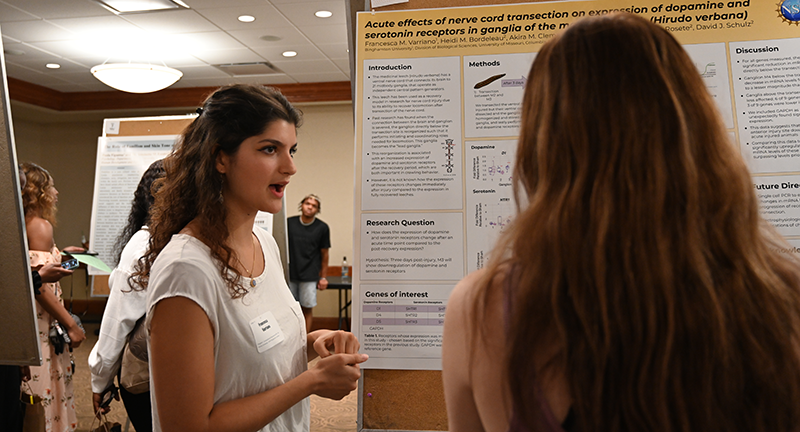July 31, 2023

Undergraduates from across the country learned how to utilize computational resources in their respective fields during a 10-week program at Mizzou.
Funded by the National Science Foundation, the Research Experiences for Undergraduates (REU) in Computational Neuroscience is led by Mizzou Engineering Professor Satish S Nair.
“The NeuroREU is geared toward students from all interested disciplines, not only engineering but also biology, psychology, physics and mathematics,” Nair said. “Students collaborate with researchers from across Mizzou, using computation and technology to solve a wide range of neuroscience problems.”
Kellen Hendrix, a psychology major at Southwest Baptist University, worked with Nelson Cowan, a Curators’ Distinguished Professor in Psychological Sciences, on working memory in first-grade children, asking whether training in story-making can help development.
“We found we can increase working memory by using a training strategy to have children create a story with some items displayed on a screen,” Hendrix said. “Students who went through that training did reliably better than children not trained. We need to look further into this type of training for working memory, as it hasn’t been investigated in short-term memory only long-term memory.”
Hendrix was already thinking about graduate school prior to the REU, but says the program gave him additional information such as opportunities like the NSF Graduate Research Fellowship Program, which funds graduate school for selected students.
“Coming here, I learned a lot I wouldn’t have otherwise,” he said. “I got to meet a lot of cool people. My mentor has been great, and I’ve learned a lot about memory, which is something I’ve been interested in for a while.”
Francesca Varriano, an integrative neuroscience major at Binghamton University worked with biological sciences Professor Davis Schulz to study the effects of serotonin and dopamine on mobility. The team specifically looking at why some animals are able to have locomotion after spinal injuries but humans are not.
“We’re hoping this adds to our understanding of locomotion and how serotonin and dopamine play a role and be able to apply that to spinal cord injury research,” she said.
Varriano said the REU program solidified her plans to attend graduate school.
“I learned a lot about what working in a lab is like, a lot of molecular biology techniques and also the human aspect of interacting with graduate students, other labs and mentors,” she said. “It’s been a great learning experience.”
Other projects from the REU in Computational Neuroscience included:
- Ryan Lewis worked with Nicole Nichols, an assistant professor in biomedical sciences, on spinal TNF, a receptor expression in a rodent model of respiratory motor neuron death.
- Elizabeth Marino and Elizabeth Price worked with Nair on modeling attention-induced firing rate modulation in morphological in silico cortical neuron, and modeling fear learning in a 1000-cell network model.
- Jennifer Aggrey worked with William Arnold, Executive Director of NextGen PHI and a Professor at MU School of Medicine, on exploring senescence biomarkers in the context of aging, neurodegeneration, and senolytic treatments.
- Christina Ntim worked with Zezong Gu, a professor at the MU School of Medicine, to study the effects of aged garlic extract for anxiolytic properties.
- Maya Steiger worked with Cowan on developmental changes in working memory and strategy use in a serial order reconstruction task.
- Celiane Tapia Suarez and Elizabeth Carlson worked with Nick Ahmed, a Ph.D. student of Professor David Beversdorf, on how prenatal supplementation impacts neuroanatomy.
Collaborate with professors across campus to improve lives. Apply today!